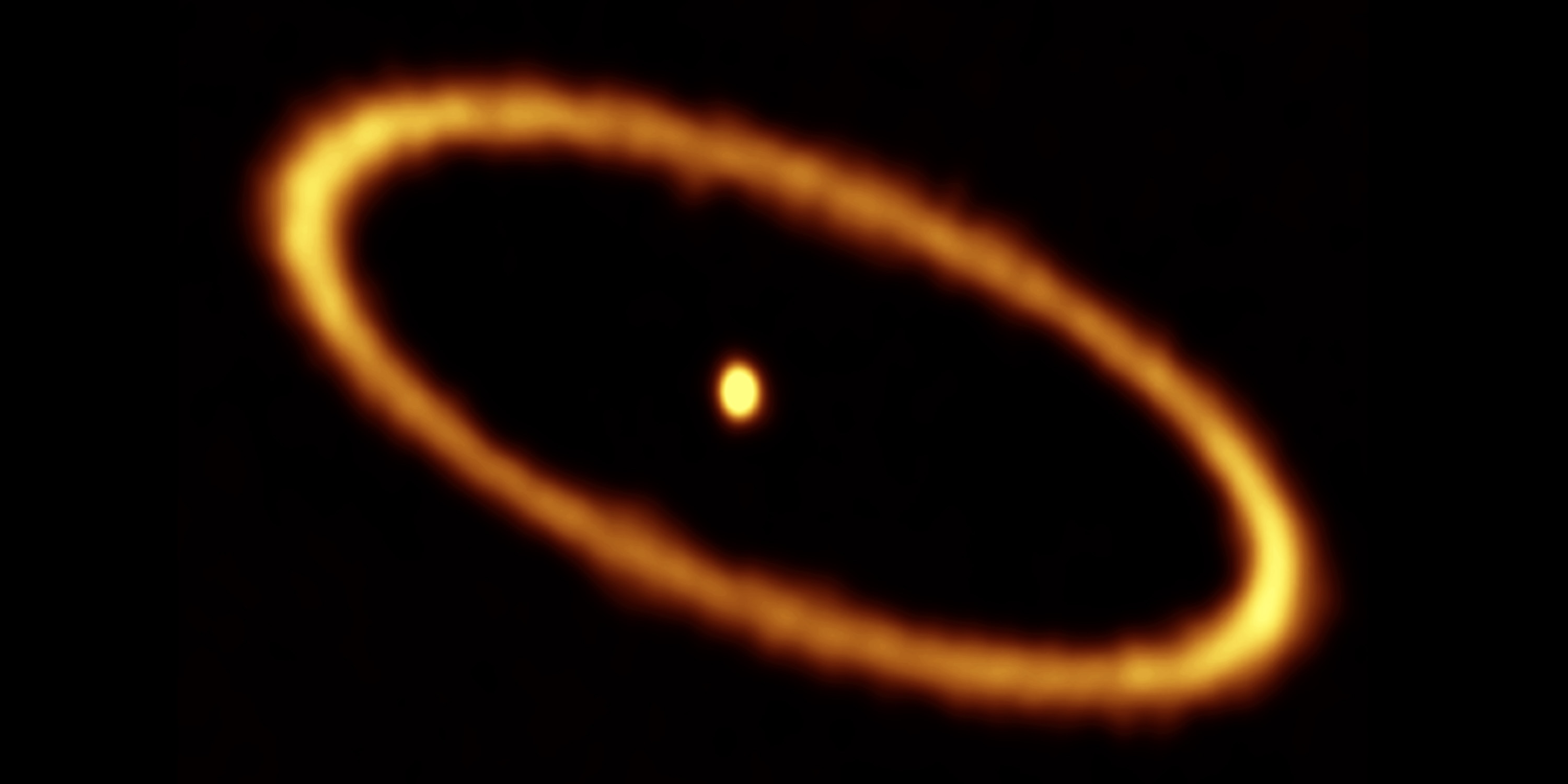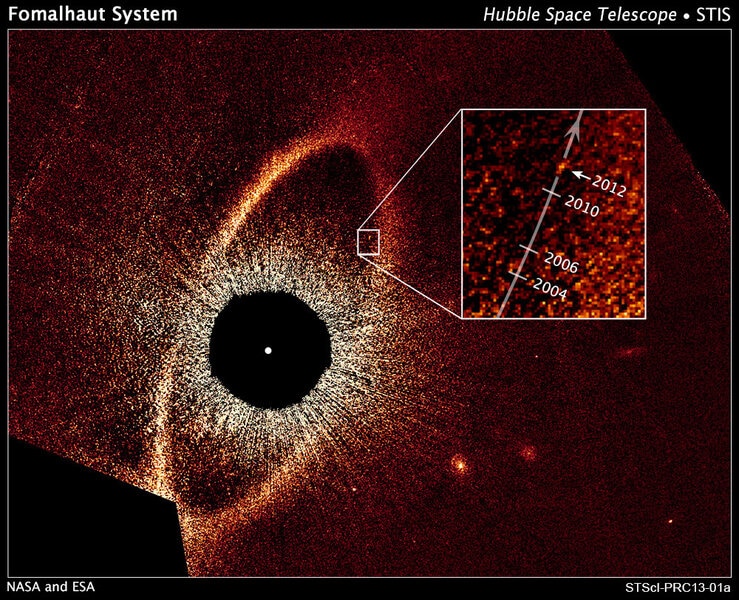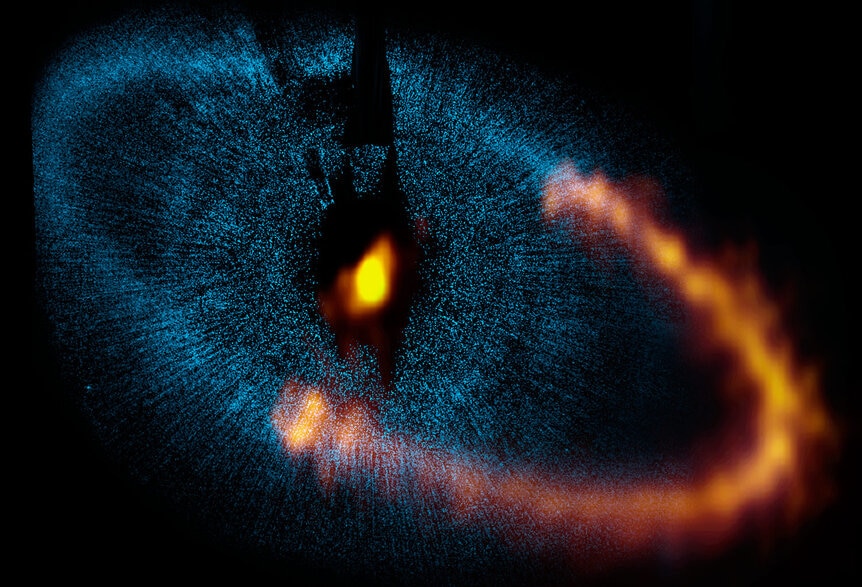Create a free profile to get unlimited access to exclusive videos, sweepstakes, and more!
Sauron’s Eye never looked so good: New observations of Fomalhaut’s dusty, icy ring

In the constellation of Pisces Austrinus (the southern fish) is one of the brightest stars in the sky, called Fomalhaut. It’s beefier than the Sun, with about twice the Sun’s mass and 16 times its luminosity. It’s one of the closest stars to us, at a distance of only 25 light-years, too.
And it has a secret. Well, had a secret. Years ago, observations indicated it was giving off more infrared light than a star of its type should. That’s a strong indication that it had a lot of dust around it —small grains of rocky material which absorb light from the star, warm up and re-emit that heat as infrared light. Observations in the 1990s confirmed that there was a ring or a disk of material surrounding the star.
Then Hubble was pointed at the star, and it clearly saw a ring around it (see images below), and it bore an eerie resemblance to Sauron’s Eye from the Lord of the Rings movies. Not only that, Hubble saw what may very well be a planet orbiting the star not too far from the ring! The existence of this planet is actually uncertain, though; it may be a cloud of dust reflecting the starlight. The motion of the object, whatever it is, indicates it’s on a highly elliptical orbit around the star and may even cross the ring’s orbit.
All of these things make Fomalhaut a juicy target for astronomers when new and better telescopes come online. That is certainly the case for ALMA, the Atacama Large Millimeter/submillimeter Array in the high desert of Chile. This powerful collection of telescopes looks at light well outside the color range our eyes can see, where warm dust glows brightly. When astronomers pointed ALMA at Fomalhaut, they saw the ring with incredible clarity, allowing a lot of scientific analysis to be performed.
Also? It’s just beautiful.
[Ring around the star: A dusty disk surrounds the nearby star Fomalhaut. Credit: ALMA (ESO/NAOJ/NRAO); M. MacGregor]
The orange color isn’t real; it’s just used in the display to let us see the ring clearly. You can see Fomalhaut itself inside the ring, stretched out a little bit due to the way the observatory sees the sky.
The ALMA observations reveal a lot about the ring. For one thing, they measure its physical properties with tight constraints. It really is an ellipse, with the material at pericenter (the closest point in its orbit to Fomalhaut) about 18 billion kilometers out, and an apocenter (farthest point) of 23 billion kilometers. For comparison, Neptune orbits the Sun at a distance of roughly 4.5 billion kilometers, so the ring is big. Its width is about 2 billion kilometers, too.
The fact that it’s a real ellipse is very interesting. We see lots of rings like this around stars, but they’re usually fairly circular, and only appear elliptical because they’re tipped with respect to us (as the circular rim of a glass looks like an ellipse when you see it at an angle). In this case, though, the ring truly is an ellipse. You can even see this by eye; if it were a tipped circle Fomalhaut would always appear be in the center. The fact that the star is noticeably off-center shows the ring’s true elliptical nature.
[Hubble image of the ring from 2012, which includes the positions of the possible planet. Credit: NASA, ESA, and P. Kalas (University of California, Berkeley and SETI Institute)]
Why is the ring this shape? Stars form from collapsing clouds of gas and dust. As the cloud collapses it flattens, and the material forms a disk. It’s densest in the center, where the star forms. The colder material farther out starts to condense, first into tiny grains, and then they collide and aggregate into bigger lumps, sometimes getting large enough to form true planets.
If a planet forms far out from the star, it can affect the dusty disk. It pulls in material around it and can shape the remaining material into a narrow ring. Not only that, but if the planet’s orbit is elliptical, it can perturb the material outside it to form an ellipse as well.
So, hmmmm. It’s still not certain that the object in the Hubble images near the ring is an actual planet (tentatively called Fomalhaut b), but the narrowness and ellipticity of the ring are strong circumstantial indicators it’s real. How about that?
There’s more. When I read about the material making up the ring, I got a chill. The ALMA observations also show the presence of carbon monoxide (CO) ice, located at the same position as the dusty ring. Careful analysis of the amount of CO there shows that it most likely came from exocomets, literally comets orbiting another star! They may undergo collisions, creating ice and dust debris that spread out along their orbits, forming the ring. But more than that, importantly, the relative amount of CO is roughly the same that you get in comets orbiting the Sun.
That’s why I got a chill. I know, intellectually, that the Sun formed like other stars, and that our planetary system is probably in many ways roughly similar to those common throughout the galaxy. But to see it in the data, to find something as seemingly unimportant as carbon monoxide abundance similar to its amount here … that gives me a kindred feeling, a connection to this object hundreds of trillions of kilometers distant. It’s like going to a boring party and finding someone else who loves the same obscure movie you do.
[Before ALMA was completed, it was able to get an image of half the ring (right, orange) which has been superposed over the Hubble image (blue, left). Credit: ALMA (ESO/NAOJ/NRAO). Visible light image: the NASA/ESA Hubble Space Telescope. Acknowledgement: A.C. Boley (University of Florida, Sagan Fellow), M.J. Payne, E.B. Ford, M. Shabran (University of Florida), S. Corder (North American ALMA Science Center, National Radio Astronomy Observatory), and W. Dent (ALMA, Chile), P. Kalas, J. Graham, E. Chiang, E. Kite (University of California, Berkeley), M. Clampin (NASA Goddard Space Flight Center), M. Fitzgerald (Lawrence Livermore National Laboratory), and K. Stapelfeldt and J. Krist (NASA Jet Propulsion Laboratory)]
There’s one more thing I want to mention. The ring is very smooth in the ALMA image, and that turns out to be real; the dust and ice appear to be evenly distributed around it … but you can see two spots on the ring that are brighter than anywhere else. At the lower left it’s brighter, and that turns out to be the pericenter, the part of the ring closest to Fomalhaut. The ALMA observations are very sensitive to temperature, and the dust is warmer there, so it appears brighter.
But there’s also another spot on the opposite side, at apocenter. The dust there is cooler, so why does it appear bright? I love this part: It’s because dust at that point in its orbit is moving the slowest around the star and piles up there. If you take a bunch of objects and spread them out evenly on an elliptical orbit, they’ll swing by the star most quickly when they’re closest and move more slowly as they pull away. So you’ll naturally see more of them at the farthest point in the orbit: They linger there longer! Since there’s more material there, that spot on the ring appears brightest. This is called the “apocenter effect,” and it’s never been seen clearly before. It was actually predicted based on some older ALMA images, but the new ones really make it obvious.
These observations are truly remarkable, telling us a lot about the ring. That’s important! We have seen lots of debris disks around stars, but those tend to be much farther away than this one. Fomalhaut’s proximity makes it a fantastic target. It also allows us to better understand how new planets interact with the material around them.
Eventually, the ring will likely disappear. The whole system is only about 440 million years old, which is relatively young (our solar system is more than 10 times older, 4.56 billion years in age). Over time, gravitational interactions with planet(s) and the stellar wind of subatomic particles blown out by Fomalhaut may erase the ring from existence.
I’m glad it’s around now for us to gawk at. And to teach us so much about how our own star, planets and comets formed.





























